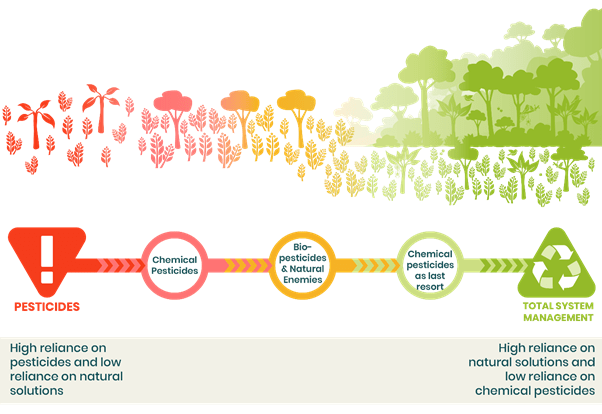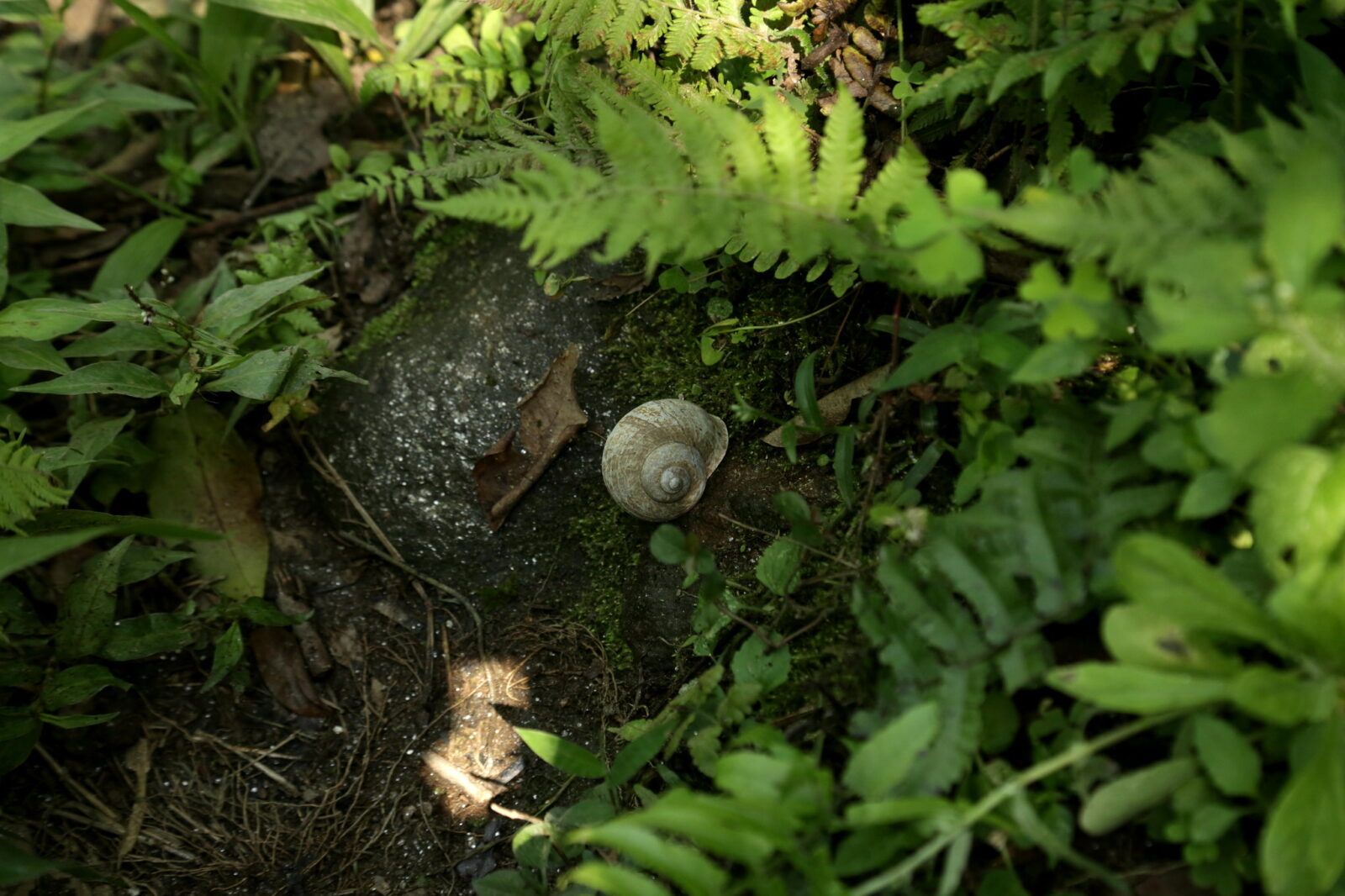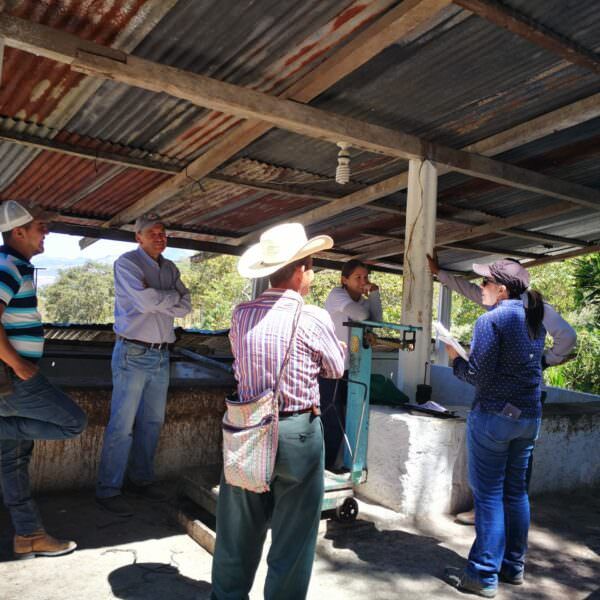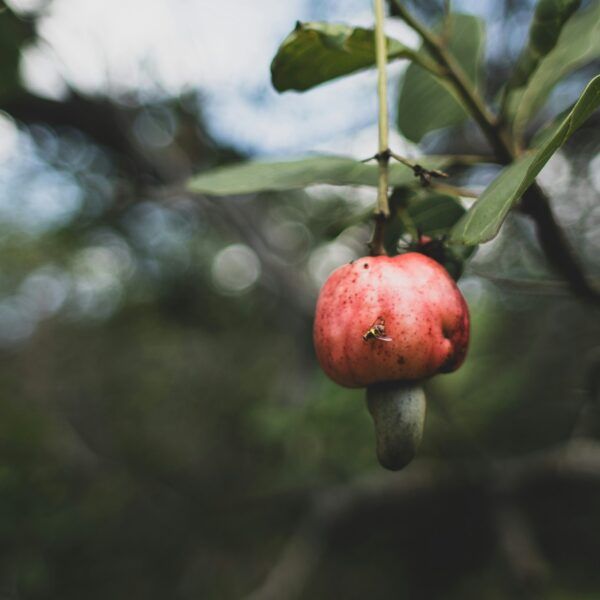To advance the transition towards sustainable and regenerative agriculture, it is crucial to increase the adoption of more environmentally friendly agricultural practices. For the Rainforest Alliance, Integrated Pest Management (IPM) is a vital component of a regenerative agricultural sector, and part of a climate-smart and a holistic approach to ecosystem management. Our IPM strategy aims to help farms develop robust plans to control pests by balancing the functions of the agroecosystem, improving ecosystem resilience, and by doing so, reducing dependence on pesticides (Figure 1).

The problem with pests and pesticides
It is estimated that every year between 20 and 40 percent of global crop production is lost to pests and diseases. Each year, plant diseases cost the global economy around US$220 billion, and insect pests around US$70 billion. But insects, diseases, and weeds are not “born” as pests. Pests are the product of an unbalanced ecosystem, and the pest status of a species depends on their numbers and the economic damage they may cause. They indicate that there is something amiss with the agroecosystem.
Pests are a constant threat for farmers, which is why the first reaction of most producers worldwide is to use pesticides. Consequently, the use of pesticides worldwide has risen 50-fold since 1950, and farmers apply approximately 3.5 billion kg of pesticides globally each year. Among these pesticides, many are classified as “highly hazardous” according to the FAO/WHO definition, meaning that they pose severe health risks for farm workers and consumers, or negatively impact biodiversity and ecosystem services through water and soil contamination.
A healthy ecosystem can boost crop quality and productivity through natural pest control, pollination, and improved soil fertility. Excessive use of pesticides, however, can disrupt necessary systemic balance. For example, destruction of natural enemy populations can cause pest species to resurge, increasing reliance on pesticides even further. Pesticide overuse is also linked to declines in pollinator populations with negative impacts on yields.
Many pesticides are also known to have adverse health effects on human health, especially when used without personal protective equipment (PPE) and the appropriate risk mitigation measures. Finally, the rising cost of many agrochemicals puts further economic pressure on farmers struggling to maintain a living income. What can we do to reduce this reliance on pesticides and the negative impact of pesticide use? A practical and cost-effective answer is IPM.
Our approach
Our approach centers around the principles of IPM, and based on context-specific and farmer-driven interventions. It focuses on harnessing the inherent strengths within agroecosystems to bring pest populations down to acceptable levels, rather than trying to eradicate them. We choose control methods that bear in mind costs and benefits and drive social and ecological sustainability. In line with all Rainforest Alliance initiatives, including the 2020 Certification Program, the ultimate priorities of our IPM approach are long-term conservation of the ecosystem, its services, and the wellbeing of people.
To support our IPM approach, we have developed an IPM Strategy, where we aim to identify the barriers to IPM adoption and help producers overcome them. Our strategy has four components: creating an IPM knowledge bank to support farmers in their journey towards more regenerative agriculture and pest control; presenting tailored IPM solutions in specific sectors and locations; building capacity and understanding of IPM through the Farmer Field School model, which promotes experimentation, demonstration, and exchange of experiences among farmers; and in an advocacy role, lobbying and advocating for shared responsibility in IPM and pesticide use.
For more information on our position regarding IPM, check the Integrated Pest Management position paper.
Pesticides approach within the 2020 Certification Program
We composed our IPM and pesticides approach on three main elements:
- Standard requirements (sections 4.5 and 4.6)
- Annex Chapter 4: Farming
- Exceptional Use Policy
Overall goal
Reduction of the use of pesticides and safe, responsible, and efficient use of agrochemicals through increased adoption of IPM.
Standard & Annex Chapter 4: Farming
The approach is based on adoption of IPM practices, where pesticides are used only as a last resort and reduction in pesticide use is demonstrated. When pesticides are used, all pesticide management safety measures and occupational health requirements are implemented. Only registered products are used; prohibited or obsolete pesticides are not used. If pesticides from the risk mitigation list are used, additional risk mitigation measures are implemented.
Exceptional Use Policy
Despite widespread efforts to reduce the use of toxic inputs in agriculture, some intensive agriculture models are still dependent on Highly Hazardous Pesticides (HHPs). To support producers on their journey to phasing out HHPs, we have developed the Exceptional Use Policy (EUP). Alongside the 2020 Rainforest Alliance Sustainable Agriculture Standard requirements, the policy grants limited exceptions to specific crop, pest, and country combinations where no feasible alternatives to HHPs are available. Specifically, exceptions are considered if no efficient, accessible, cost-effective alternatives are available, or if prohibiting the substance in question would put the economic sustainability of the agricultural operation at risk. When exceptions are granted, we require producers to take measures to mitigate and compensate for the negative impacts these pesticides have on people and the environment, while actively seeking out less toxic alternatives. Details of these exceptions and their conditions are included in the Exceptional Use Policy (EUP).
The EUP is built on producers’ requests and a sound understanding of local conditions, combined with the pesticide mitigation approach outlined in our IPM Strategy. The process of developing the EUP includes an extensive, thorough, and context-specific technical analysis of the farmers’ needs in terms of pest pressures and available alternatives. This analysis is carried out by the Rainforest Alliance IPM team and a panel of external scientists and technical experts with extensive knowledge of sustainable production and global expertise in the Rainforest Alliance key agricultural sectors. We also draw from external tools such as Homologa®, the Global Crop Protection database, to assess country-specific details on registered pesticides and Maximum Residue Limits, and the CABI BioProtection Portal, to identify biological control alternatives locally available.
Producers can submit their requests at any time, following the procedure established in Annex Chapter 4: Farming. Based on the received requests, we update the EUP every six months, following the schedule shown here:

For the sake of transparency, the links below contain the requests we have received for each version of the EUP, as well as our final decisions and justification.
- II Semester 2020 (EUP V 1) – Requests & final decisions
- I Semester 2021 (EUP V 1.1) – Requests & final decisions
- II Semester 2021 (EUP V 1.2)- Requests & final decisions
- I Semester 2022 (EUP V 1.3) – Requests & final decisions
- II Semester 2022 (EUP V1.4) – Requests & final decisions
- I Semester 2023 (EUP V 1.5) – Requests & final decisions
- II Semester 2024 (EUP V1.6) – Requests & final decisions
Useful links on IPM and pesticides
- The CABI BioProtection Portal, a free tool to discover natural, registered biocontrol and biopesticides around the world: Biocontrol and biopesticide products – BioProtection Portal
- What Is Regenerative Agriculture?
- Integrated Pest Management and Natural Farming Solutions Position Paper
- Guidance H: Integrated Pest Management
- Guía de Manejo Integral de Hierbas en Cafetales
- Guía Ilustrativa del Manejo Integral de Hierbas en Cafetales
- Application of Triazoles for Control of Coffee Leaf Rust (Hemileia Vastatrix)
- Guidance: Empty pesticide container disposal in Vietnam




